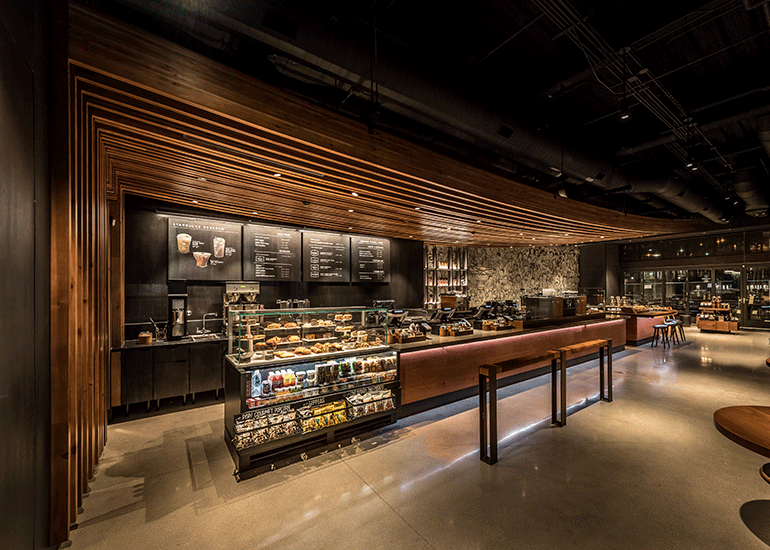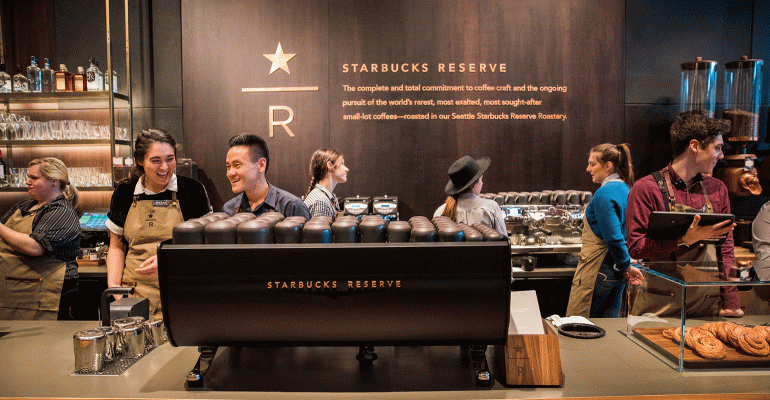Seattle-based Starbucks Corp. is retreating from its initial aggressive approach to the expansion of its Reserve store formats.
In a Wall Street Journal article earlier this week, CEO Kevin Johnson referred to the original goal of 1,000 stores as “aspirational,” signaling a departure from the full-steam ahead approach from his predecessor’s tenure. This news led to some confusion in the press about what the original goal was for the Reserve stores, what exactly differentiates the Reserve store formats, and what’s the new plan of action.
Nation’s Restaurant News combed through the coffee chain’s earlier statements to track the progression and messaging around the Reserve brand.

The Starbucks Reserve Roastery in Manhattan
What the “Reserve” brand is:
When Starbucks launched its Reserve coffee brand in 2010 — a line of carefully sourced and roasted craft coffee creations — the chain was trying to broaden its appeal to more serious coffee connoisseurs to compete with third-wave coffee houses.
Since 2014, the new artisanal coffee selection spurred a series of Starbucks store formats that catered toward the more discerning customer: the Reserve Roastery, an immersive multi-story coffee megaplex with an in-house roastery, cocktail bar, and Princi bakery with four locations around the world; the Reserve Store, the “smaller cousin” of the Roastery, currently with one location in Seattle; and the Reserve Bar, which serves premium Roastery coffee in the classic Starbucks environment, minus the Princi bakery, with 20 United States locations and 150 locations in China.
When Starbucks opened its first Reserve Roastery in 2014, former CEO Howard Schultz was all in with the new premium brands. In 2016, just months before he stepped down as CEO, Schultz announced aspirations to open 1,000 Starbucks Reserve stores around the world, along with 20-30 Roasteries. He said that Starbucks “will now accelerate and globalize the Roastery experience” by adding the Roastery experience to “hundreds of new coffee-forward Reserve stores” around the world.

The Starbucks Reserve Roastery in Seattle
Since Kevin Johnson was named CEO of Starbucks in 2017, he has taken a decidedly more conservative approach to the premium coffee brand with renewed targets of 6-10 Reserve stores before planning further expansion. The shift reflects a cautious response to the chain’s struggles with declining traffic over the last year.
Although fiscal year same-store sales were up 2 percent globally for Starbucks in 2018, the growth was driven by price increases.
A timeline of the evolving goals for the Starbucks Reserve store formats over the past four years:
December 2014: The first Starbucks Reserve Roastery opens
Starbucks opened its first Reserve Roastery in Seattle: a 15,000 square-foot facility that focused on roasting and distribution of the brand’s Starbucks Reserve coffee. At the time, Starbucks estimated that it would be bringing its Reserve coffee line to 1,500 locations around the world, with plans for 100 stores dedicated to the premium coffee brand in Chicago, Los Angeles, New York, San Francisco and Washington D.C.

The Starbucks Reserve Bar in Chicago
April 2015: Starbucks announces plans for 500 Reserve Bars
Starbucks announced plans to bring its Starbucks Reserve coffee to 500 Starbucks stores around the world in the form of the Reserve Bar. The stores will “showcase the most premium of all super-premium coffees in the world and the newest coffee brewing methods,” CEO Howard Schultz said at the time.
July 2016: Starbucks announces plans for more than 500 Reserve Stores
In a July 2016 letter to employees, then-CEO Howard Schultz said that the ambitious plans for more than 500 Reserve stores represent a “look around the corner” as Starbucks moved into an era of innovation.
November 2016: Starbucks puts plans into motion for 1,000 Starbucks Reserve Stores
In a November call with Wall Street analysts, Howard Schultz emphasized his optimistic view of the Starbucks Roastery and Reserve stores. He said that he envisions 20 to 30 Roasteries around the world, and “significant growth” for the Reserve store brands with “the potential for 1,000 or more locations.” Schultz expected to add 1,000 Reserve Bars to Starbucks stores in 2017.

Kevin Johnson and Howard Schultz
December 2016: Schultz announces he is stepping down as CEO
Schultz announced that he would be stepping down as CEO in April 2017 and would become executive chairman to focus on the development of Starbucks Reserve Roasteries around the world. He would hand the reins over to then-COO Kevin Johnson.

The Starbucks Reserve Roastery in Shanghai, China
December 2017: Starbucks’ second Reserve Roastery location opens
Starbucks opens its second Roastery location — a 30,000 square-foot space with a Teavana bar and other premium brand amenities — in Shanghai, China.

The Starbucks Reserve Store in Seattle
February 2018: The first Starbucks Reserve Store opens
Starbucks opens its first Reserve Store with an adjacent Princi bakery at its headquarters in Seattle: a café with all of the trappings of the Reserve Roasteries, minus the roastery itself. At the time, Starbucks had made no changes to its goals to open 1,000 locations of the Starbucks Reserve store.
June 4, 2018: Howard Schultz announces he is stepping down as chairman
Schultz announced that he would step away from Starbucks completely following a racial bias scandal in April 2018, and amidst speculation that he could be considering a run for president.
June 19, 2018: CEO Kevin Johnson outlines new goals for Reserve brands
At the Oppenheimer Consumer Growth and e-Commerce Conference, Johnson explained that the Seattle Reserve store is still in concept phase and Starbucks would build 6-10 more concept stores before transitioning into their “commercial phase,” or further expansion. At the time, four more Roasteries were under construction: Milan, New York, Chicago, and Tokyo.
“We're going to stay with where we're at on six of these Roasteries for right now until we continue to see how they evolve and the economics of them going forward,” Johnson said at the time.
Johnson did not mention previous targets of 1,000 Reserve Store or Bar locations set by his predecessor.

The Starbucks Roastery in Milan
September 2018: Starbucks Roastery Milan opens
Starbucks opens its third roastery globally: a 25,000-square-foot facility in Milan’s city square, Piazza Cordusio.

The Starbucks Reserve Roastery in Manhattan
December 2018: Starbucks Roastery New York opens
The fourth Starbucks Reserve Roastery opens in Manhattan. This location is home to the upscale brand’s signature bakery, roastery, cocktail bar, and a coffee-inspired terrarium.
Jan. 7, 2019: CEO Kevin Johnson acknowledges that ‘1,000 stores was an aspiration’
Starbucks CEO Kevin Johnson acknowledged his predecessor’s lofty goals for his Reserve brands in an interview with the Wall Street Journal.
“One thousand was an aspiration,” Johnson said, reiterating the chain’s revised conservative estimate of opening 6 to 10 stores before heading into an expansion phase.
“Starbucks aspirational goals for both Reserve Store and Reserve Bar formats remain unchanged,” a Starbucks representative told Nation’s Restaurant News. “As CEO, Kevin Johnson has laid out a disciplined approach to prove out the concept phase of these formats before transitioning to commercial phase.”
Starbucks would not comment on what the non-aspirational goals are for the Reserve brand in coming years.
Contact Joanna Fantozzi at [email protected]
Follow her on Twitter: @JoannaFantozzi

